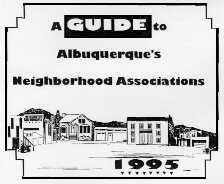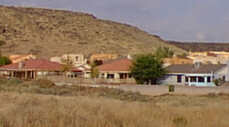Since 1980 more and more Albuquerqueans have come to identify themselves as residents of a particular neighborhood, e.g., Barelas, Martineztown, La Mesa, Hoffmantown, Old Town, Nob Hill, Taylor Ranch, etc.
While this neighborhood identification has become most visible recently, the older sections of Albuquerque began to take on a specific neighborhood identity as early as the 1930s, and then organized themselves into associations that were quasi political, social, and self-protective in nature.
Albuquerque city government has long recognized the existence of these distinctive smaller communities within the larger metropolitan area. The Albuquerque/Bernalillo County Comprehensive Plan emphasizes the diversity of needs, resources, and atmospheres and proposes that the most satisfactory solution to many urban problems lies in the recognition of the uniqueness of neighborhoods and the fostering of neighborhood input into the planning and development of each area.
The 1983-84 Goals Committee Report recognized the need to establish effective relationships between neighborhood associations and city agencies to facilitate communication and input by private citizens who live in neighborhoods to the city government. The same report recognized a trend in Albuquerque that reflects a nationwide trend towards more citizen participation in municipal government.
The city of Albuquerque in 1995 established the Community Identity Plan, utilizing the input from two years of surveys and workshops. The goal is to create collaborative partnerships in the ten areas identified as our urban communities. Each partnership team will be composed of city staff and representatives of neighborhoods, business and civic associations, and other community organizations and interest groups, including developers. Each team will be a link between city government and the public for identifying goals and priorities and improving ongoing communications and understanding between neighborhoods and their government.
 |
The over 230 self-identified neighborhood groups in Albuquerque today reflect a variety of concerns and interests, as noted in the Guide to Albuquerque Neighborhood Associations, published by the Office of Neighborhood Coordination. This directory and the existence of the city-funded office that published it, attest to the growing realization by the political system that neighborhoods are here to stay.
Why these groups have proliferated is a subject of much conjecture--some feel that their presence indicates a deficiency in government; others think it is a sign of healthy input by those the government serves. How these relationships between citizen groups and governmental agencies are handled is the subject of many articles in journals, discussions at citizen forums, and national conferences. The difference between neighborhood self-determination and neighborhood input is a subject to be dealt with both by neighborhood groups and governmental entities, either in the privacy of their own four walls or in shared discussions. Many who are supportive of neighborhood input are very much opposed to any plan that smacks of neighborhood self-determination.
 |
One of the most common arguments advanced by those who oppose any move to formalize neighborhood input is the belief that neighborhood groups cannot get beyond their parochial and vested-interest views on citywide issues. However, during the past few years, neighborhood associations are forming coalitions along geographic or city council district boundaries. These coalitions provide a means for neighborhoods to achieve and maintain communication between and among themselves and other organizations, both public and private, and to work together to preserve, protect, and enhance their neighborhoods and the greater Albuquerque community.
The city of Albuquerque's policy towards the notification of neighborhood groups and the public in general is determined both by ordinance and administrative policy. The zoning ordinance deals with notification of neighborhood associations in only one aspect of zoning. However, the establishment of the Office of Neighborhood Coordination (with its charge to develop better communication between neighborhood groups and the city) encourages timely notification in matters of zoning and development of facilities that involve the neighborhoods.
The decisions to be made in light of the growing number of associations and the input provided by the Goals for Albuquerque project are critical in terms of timeliness and the eventual impact on city development and planning. These decisions will affect the city and its environment for years to come.
(Up to Section V, Back to Landscaping, On to Noise)